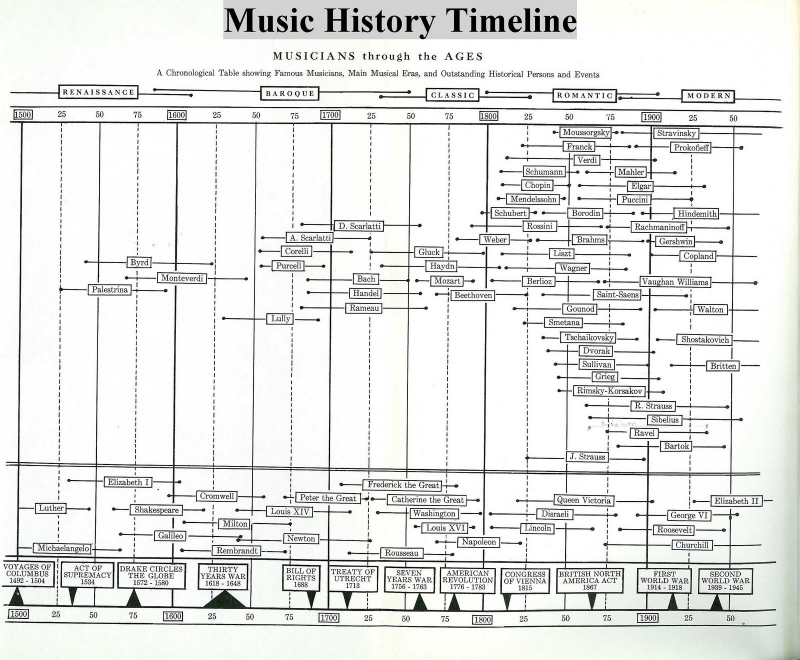อยากรู้
napalm.potter
มันเป็นแนวเพลง ไม่ได้เกี่ยวกับความเก่าของเพลง เพียงแต่ว่าบางช่วงอาจมีแนวเพลงบางประเภทที่ได้รับความนิยมมากกว่าปกติ ทำให้เข้าใจไปว่ายุคนั้นเป็นเพลงแนวนี้
The Oldest known musical melody performed by the very talented Michael Levy on the Lyre. This ancient musical fragment dates back to 1400 B.C.E. and was discovered in the 1950's in Ugarit, Syria. It was interpreted by Dr. Richard Dumbrill.
The history of music is as old as humanity itself. Archaeologists have found primitive flutes made of bone and ivory dating back as far as 43,000 years, and it’s likely that many ancient musical styles have been preserved in oral traditions. When it comes to specific songs, however, the oldest known examples are relatively more recent. The earliest fragment of musical notation is found on a 4,000-year-old Sumerian clay tablet, which includes instructions and tunings for a hymn honoring the ruler Lipit-Ishtar. But for the title of oldest extant song, most historians point to “Hurrian Hymn No. 6,” an ode to the goddess Nikkal that was composed in cuneiform by the ancient Hurrians sometime around the 14th century B.C. The clay tablets containing the tune were excavated in the 1950s from the ruins of the city of Ugarit in Syria. Along with a near-complete set of musical notations, they also include specific instructions for how to play the song on a type of nine-stringed lyre.
“Hurrian Hymn No. 6” is considered the world’s earliest melody, but the oldest musical composition to have survived in its entirety is a first century A.D. Greek tune known as the “Seikilos Epitaph.” The song was found engraved on an ancient marble column used to mark a woman’s gravesite in Turkey. “I am a tombstone, an image,” reads an inscription. “Seikilos placed me here as an everlasting sign of deathless remembrance.” The column also includes musical notation as well as a short set of lyrics that read: “While you live, shine / Have no grief at all / Life exists only for a short while / And time demands its toll.”
The well-preserved inscriptions on Seikilos Epitaph have allowed modern musicians and scholars to recreate its plaintive melodies note-for-note. Dr. David Creese of the University of Newcastle performed it using an eight-stringed instrument played with a mallet, and ancient music researcher Michael Levy has recorded a version strummed on a lyre. There have also been several attempts to decode and play “Hurrian Hymn No. 6,” but because of difficulties in translating its ancient tablets, there is no definitive version. One of the most popular interpretations came in 2009, when Syrian composer Malek Jandali performed the ancient hymn with a full orchestra.
ประวัติความเป็นมาของดนตรีนั้นเก่าแก่พอ ๆ กับมนุษยชาติ นักโบราณคดีพบว่าขลุ่ยโบราณที่ทำจากกระดูกและงาช้างย้อนหลังไปถึง 43,000 ปีและเป็นไปได้ว่ารูปแบบดนตรีโบราณจำนวนมากได้รับการเก็บรักษาไว้ในประเพณีทางปาก เมื่อพูดถึงเพลงที่เฉพาะเจาะจงตัวอย่างที่เก่าแก่ที่สุดที่รู้จักนั้นค่อนข้างจะค่อนข้างล่าสุด ชิ้นส่วนที่เก่าแก่ที่สุดของโน้ตดนตรีพบได้บนแท็บเล็ตดินเผา Sumerian อายุ 4,000 ปีซึ่งรวมถึงคำแนะนำและการปรับจูนสำหรับเพลงสวดที่เคารพผู้ปกครอง Lipit-Ishtar แต่สำหรับชื่อเพลงที่เก่าแก่ที่สุดที่ยังหลงเหลืออยู่นักประวัติศาสตร์ส่วนใหญ่ชี้ไปที่ "Hurrian Hymn No. 6" ซึ่งเป็นบทกวีของ Nikkal ที่แต่งขึ้นในรูปแบบของ Hurrians โบราณราว ๆ ศตวรรษที่ 14 ก่อนคริสต์ศักราช เม็ดดินเหนียวที่มีการแต่งเพลงถูกขุดขึ้นมาในช่วงปี 1950 จากซากปรักหักพังของเมืองอูการิทในซีเรีย นอกเหนือจากชุดโน้ตดนตรีที่ใกล้เคียงแล้วพวกเขายังมีคำแนะนำเฉพาะสำหรับวิธีการเล่นเพลงในพิณเก้าสาย
"Hurrian Hymn No. 6" ถือเป็นท่วงทำนองที่เก่าแก่ที่สุดของโลก แต่การประพันธ์เพลงที่เก่าแก่ที่สุดที่ยังมีชีวิตรอดได้คือศตวรรษที่ 1 A.D เพลงกรีกที่รู้จักกันในชื่อ "Seikilos Epitaph" เพลงนี้ถูกแกะสลักบนเสาหินอ่อนโบราณที่ใช้ทำเครื่องหมายหลุมศพของผู้หญิงในตุรกี “ ฉันเป็นหลุมฝังศพ, รูปภาพ” จารึกอ่าน “ เซกิโลสวางฉันไว้ที่นี่เป็นสัญญาณบ่งบอกถึงความทรงจำนิรันดร์ที่ไม่มีวันตายตลอดไป” คอลัมน์นี้ยังรวมถึงโน้ตดนตรีและเนื้อเพลงสั้น ๆ ที่อ่านว่า:“ ในขณะที่คุณมีชีวิตเปล่งประกาย / ไม่มีความเศร้าโศกเลย / ชีวิตมีอยู่เพียงช่วงสั้น ๆ เท่านั้น / และเวลาต้องการเวลา”
ศิลาจารึกที่ได้รับการอนุรักษ์ไว้เป็นอย่างดีบน Seikilos Epitaph ทำให้นักดนตรีและนักวิชาการสมัยใหม่สามารถสร้างท่วงทำนองที่น่าจดจำได้ ดร. David Creese แห่งมหาวิทยาลัยนิวคาสเซิลทำการแสดงโดยใช้เครื่องดนตรีแปดสายเล่นกับตะลุมพุกและนักวิจัยดนตรีโบราณ Michael Levy ได้บันทึกเวอร์ชันที่ก้าวร้าวเป็นพิณ มีความพยายามหลายครั้งในการถอดรหัสและเล่น“ Hurrian Hymn No. 6” แต่เนื่องจากความยากลำบากในการแปลแท็บเล็ตโบราณของมันจึงไม่มีเวอร์ชั่นที่ชัดเจน หนึ่งในการตีความที่นิยมมากที่สุดมาในปี 2009 เมื่อนักแต่งเพลงชาวซีเรีย Malek Jandali แสดงเพลงสวดโบราณที่มีวงออเคสตราเต็มรูปแบบ

